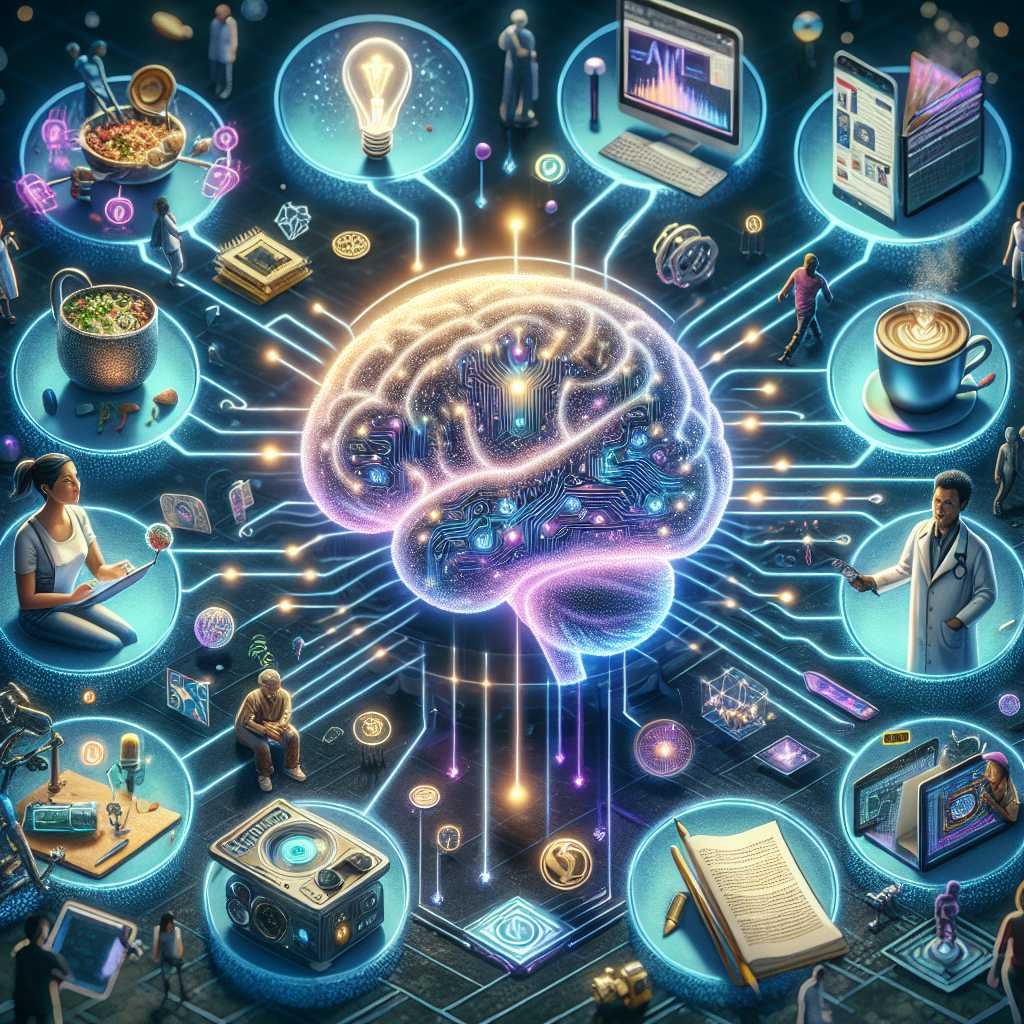7 Shocking GPT‑5 Features You Can Use Today (Quantum Sparks): The Next Leap in Tech and What It Means for Daily Life
If you’ve felt the pace of AI accelerate lately, you’re not imagining it. We’re moving from “type a prompt, get a response” to live, multimodal systems that see, hear, speak, and act across your apps—often in real time. That’s why talk of “GPT‑5” feels electric: not just more of the same, but a step-change in how we think, create, and work.
Here’s the twist: while the official “GPT‑5” isn’t publicly released yet, you can already use many of the headline features people expect from it—today. The latest multimodal models, memory features, tailored GPTs, and real-time agents are unlocking workflows that would’ve sounded like science fiction two years ago. In this guide, I’ll show you seven “GPT‑5‑level” capabilities you can try right now, along with practical use cases, buying tips, and a step-by-step roadmap to bring them into your daily life.
Wait—Is GPT‑5 Actually Here? A Reality Check
Let’s set expectations. As of now, OpenAI hasn’t publicly launched a model formally named “GPT‑5.” But a wave of advanced capabilities—multimodal reasoning, live video understanding, persistent memory, tool use, and agentic workflows—are already available in leading systems like GPT‑4o and similar next‑gen models. You can interact with AI via voice, images, and camera streams; you can build custom GPTs tailored to your workflows; and you can let AI call tools, parse files, and take actions.
- Real‑time multimodal features: See what’s possible with the new Realtime APIs and multimodal models described by OpenAI in their product updates and model overviews. For a primer, start with OpenAI’s announcements on multimodal models like GPT‑4o and real‑time interaction (OpenAI).
- Broader context: The 2024 AI Index explains why we’re at an inflection point in capability, cost, and adoption (Stanford HAI).
Think of this article as your field guide: what “GPT‑5” will feel like—and how to use its most valuable features with tools you can access today.
Want the deeper playbook and real‑world walkthroughs from this article in one place? Check it on Amazon.
The 7 “GPT‑5” Features You Can Use Today
Below are seven capabilities that define the next wave of AI. For each one, I’ll show how it changes your day and how to try it now with currently available tools.
1) Multimodal Intelligence: Text, Image, Voice, and Live Video
What it is: Instead of just reading text, the model can “see” images, “watch” live video, and carry a conversation via voice. Picture pointing your phone’s camera at a whiteboard and saying, “Turn this into a project plan and email it to the team.”
Why it matters: Multimodal systems shrink the gap between thinking and doing. You narrate your intent; the model interprets context from the world around you.
Try it now: – Use a multimodal model that accepts image uploads to analyze screenshots, design mocks, receipts, or hand-drawn notes. – Explore live camera inputs for tasks like “diagnose why this 3D printer jammed,” “grade these math worksheets,” or “explain this circuit.” – Do voice conversations to brainstorm, summarize meetings, or get coaching with immediate follow‑ups.
Pro tip: For creative work, ask the model to “explain its reasoning” at a high level—flowcharts, outlines, or bullet logic can help you validate results without bloating tokens.
2) Custom GPTs That Adapt to Your Goals
What it is: You can now create tailored GPTs (or “agents”) that follow your instructions, summon specific tools, and maintain a consistent style or process. Imagine a “Brand Style Guardian” GPT that edits drafts, enforces voice guidelines, and exports final copy to your CMS.
Why it matters: One-size-fits-all chat is dead. Custom GPTs unlock repeatable, reliable output that feels like onboarding a specialized teammate.
Try it now: – Train a custom GPT with a short system prompt (“You are my product marketing editor…”) and a library of examples (approved briefs, style guides, FAQs). – Add tool use: connect it to your docs, calendars, or project software via APIs so it can gather context and take actions. – Set up guardrails: define what it should never do, and include a “fallback policy” (e.g., “If uncertain, ask for one clarifying question before proceeding”).
Want my template pack for spinning up high‑quality custom GPTs for marketing, dev, and ops? Buy on Amazon.
3) Persistent Memory: AI That Remembers Preferences and Progress
What it is: Memory lets the AI recall your preferences across sessions—tone, formatting, tech stack, recurring stakeholders—so it learns you over time.
Why it matters: Reduced friction. Less re‑explaining. More continuity. When your assistant already knows you want “executive summaries under 120 words with bullet highlights,” your throughput skyrockets.
Try it now: – Enable memory features (where available) and explicitly teach preferences: “Remember that I use British spelling and prefer Chicago style.” – Store project context: “My Q3 goal is a 15% increase in trial conversions; use lean A/B tests with two variants max.” – Periodically audit: Ask, “What do you remember about my preferences and current projects?” Update or delete as needed.
Ethics tip: Be mindful of what you ask the model to remember. Keep personal data minimal and review privacy settings periodically.
4) Real‑Time Agents That See, Think, and Act
What it is: Agentic workflows let the model take a task, break it into steps, call tools, handle errors, and loop until the objective is met. Combined with real‑time inputs (voice/video), you get an assistant that can, for example, troubleshoot a smart device, draft a proposal, and create a calendar invite—hands‑free.
Why it matters: It’s not just “answers.” It’s outcomes.
Try it now: – Connect your AI to actions: email sending, calendar creation, database writes, ticket creation, spreadsheet updates. – Build “standard operating prompts”: “You’re my assistant for hiring. For each resume: rank, summarize skills, flag deal-breakers, draft a reply.” – Add error handling: “If you receive a 400 error from the API, retry once; otherwise, alert me with a plain‑English summary.”
Want to practice building your first agentic SOP with a simple checklist and prompts? Shop on Amazon.
5) Developer Superpowers: Code, Debug, and Ship Faster
What it is: Modern models don’t just autocomplete—they reason about your codebase, write tests, propose architectures, and even generate pull requests. Pair that with tool use, and your AI can run snippets, parse logs, and troubleshoot environments.
Why it matters: You turn “figuring it out” time into shipping time.
Try it now: – Give the model your repo structure and a small set of key files; ask for an architecture diagram, a dependency map, or a performance profile. – Use it for test‑first development: have it draft tests from your user stories before writing the implementation. – Ask for “rubber duck” guidance: “Explain why my async queue stalls under load and propose three fixes with trade‑offs.”
Security note: Never paste secrets. Mask tokens and keys. Use read‑only access when possible and review every change via PR.
6) Knowledge Workflows: From Messy Inputs to Executive‑Ready Outputs
What it is: The model ingests diverse inputs—PDFs, spreadsheets, meeting transcripts—and produces clean, ready‑to‑use deliverables: strategy docs, slide outlines, SOPs, and email campaigns.
Why it matters: Most knowledge work is “transform messy into usable.” AI does this consistently and fast.
Try it now: – Feed the AI your “source bundle”: an agenda, research notes, customer quotes, and a results spreadsheet. – Ask for a structured output with format constraints: “Two‑page brief: goals, audience, message, risks, metrics. Include a 90‑day rollout timeline.” – Iterate: “Shorten the executive summary to 90 words. Add a one‑slide talking points version for sales.”
Pro tip: Use role‑play prompts to stress test: “Play a skeptical CFO and poke holes in this plan; then revise the recommendation.”
7) Human‑Centered Coaching: Skills, Feedback, and Learning Loops
What it is: The new generation of models can coach, not just inform—tutoring math step‑by‑step, practicing languages, or running mock interviews with targeted feedback.
Why it matters: Tailored learning accelerates skill growth. The model becomes a patient teacher and a relentless practice partner.
Try it now: – Ask for scaffolded lessons: “I’m B2 Spanish; quiz me for 10 minutes, then correct errors and suggest drills.” – Use “explain like I’m X” prompts: “Explain gradient descent like I’m a first‑year CS student with basic calculus.” – Pair with real data: “Review this sales call transcript and give me specific coaching on discovery questions and objection handling.”
If you want structured coaching sequences (prompts + rubrics + practice sets), View on Amazon.
Real‑World Impact: How These Features Change Work and Life
We’re already seeing measurable gains across industries:
- Education: AI tutoring improves access, scaffolds learning, and supports teachers with planning and grading. See broader discussions around equitable AI in education from UNESCO.
- Healthcare: AI assists with intake summaries, differential diagnosis support, and patient education, while raising important safety and ethics considerations (WHO).
- Business operations: Generative AI boosts productivity in marketing, service, and software development—especially when integrated with workflows and data (McKinsey).
Here’s why that matters: adoption isn’t about replacing people—it’s about amplifying judgment, compressing time‑to‑insight, and moving from busywork to real impact.
How to Choose the Right AI Setup: Buying Tips, Specs, and Tools
You don’t need a supercomputer to benefit, but a thoughtful setup reduces friction and latency.
What to consider: – Microphone and audio: Clear voice input reduces transcription errors. A decent USB mic (or a headset with noise cancellation) is a game‑changer for real‑time voice. – Camera: For live video features, a 1080p or better webcam with good low‑light performance helps the model “see” diagrams, devices, and documents. – Local horsepower: While inference runs in the cloud, local CPUs/NPUs matter for on‑device preprocessing, screen recording, or running lightweight models. Modern chips (Apple M‑series, AMD Ryzen AI, Intel Core Ultra, Qualcomm X Elite) often include NPUs optimized for AI tasks. – Connectivity: Stable, low‑latency internet is crucial for real‑time voice/video interactions. – Privacy tools: Consider separate work and personal profiles, encrypted storage for sensitive files, and a secrets manager.
Compare options and see what fits your workflow best before you buy—then optimize over time as your use cases evolve. If you want a curated list of starter gear and software picks, See price on Amazon.
Configuration tips: – Keep a “clean mic” setup: a push‑to‑talk hotkey and a quiet room help a lot. – Use screen regions: when sharing, crop to the relevant window to reduce noise. – Maintain a prompt library: store your best system prompts for writing, coding, and analysis so every session starts strong.
Privacy, Safety, and Governance: Adopt AI the Right Way
Responsible use isn’t optional—especially in regulated industries.
- Data handling: Minimize PII, anonymize records when possible, and use data‑processing agreements that fit your compliance needs.
- Prompt hygiene: Don’t paste secrets. Use vaults, environment variables, and redaction tools.
- Governance: Define policies for tool access, logging, and human oversight. Build audit trails for key actions like sending emails or updating records.
- Risk frameworks: NIST’s AI Risk Management Framework is a solid starting point for assessing risks and controls (NIST).
If you’re rolling this out for a team, create a short “AI use policy” doc with do/don’t examples, escalation paths, and privacy settings—then revisit quarterly.
Want an editable policy template and risk checklist tuned for small teams? Shop on Amazon.
A 7‑Day Starter Plan to Put This Into Practice
You don’t need to overhaul everything at once. Here’s a simple, low‑risk rollout you can start this week.
Day 1: Multimodal sanity check – Try a voice session to brainstorm and a quick image analysis task (e.g., summarize a whiteboard photo). – Note latency, transcription accuracy, and any friction.
Day 2: Personal memory setup – Teach preferences: tone, formatting, meeting cadence. – Ask the model to recite what it remembers and correct anything off.
Day 3: Custom GPT for a single workflow – Pick one repeatable task: blog edits, weekly reports, or support triage. – Provide 2–3 good examples and negative examples (what to avoid).
Day 4: Light tool integration – Connect to a calendar or task manager via API/automation. – Define guardrails: approval steps and error reporting.
Day 5: Knowledge transformation – Drop in a messy bundle (notes, PDF, spreadsheet). – Ask for a 2‑page brief and a one‑slide TL;DR. Iterate.
Day 6: Feedback and coaching loop – Run a mock call, interview, or presentation with voice. – Request targeted feedback and an improvement plan.
Day 7: Debrief and scale – What worked? Where did it break? – Add one more workflow or deepen tool integrations.
By the end of a week, you’ll have tangible wins and a clear sense of where to invest next.
Common Pitfalls (And How to Avoid Them)
- Vague prompts: Be explicit about format, audience, and constraints.
- One‑off sessions: Without memory, you’ll repeat yourself. Enable memory or store context snippets.
- Tool chaos: Start with one or two integrations. Add more only after they prove value.
- Over‑automation: Keep a human in the loop for high‑impact tasks like customer emails or contract changes.
- Neglecting evaluation: Track outcomes. Did the brief save 45 minutes? Did the agent create fewer errors than your manual process?
Future‑Proofing Your AI Strategy
Even as capabilities evolve, the fundamentals stay the same: – Build durable assets: prompt libraries, custom GPTs, knowledge bases, and SOPs. – Prioritize data quality: Clean inputs produce better outputs. – Document workflows: Make it easy for others to replicate your wins. – Stay informed: Follow reputable research and policy sources so you can adopt new features responsibly (e.g., OpenAI blog, Stanford HAI, NIST).
The tech will change; your habits and systems will compound.
FAQs: People Also Ask
Q: Is GPT‑5 released yet? A: Not publicly. However, many “GPT‑5‑like” features—multimodal interaction, real‑time voice/video, advanced tool use, and memory—are already available in current top models and platforms.
Q: What’s the difference between GPT‑4o and the rumored GPT‑5? A: GPT‑4o (and similar multimodal models) already handle text, image, audio, and real‑time inputs with strong reasoning. “GPT‑5” is expected to push further on reasoning, robustness, speed, and agentic autonomy. Until it’s officially released, treat “GPT‑5” as shorthand for the next wave of capabilities.
Q: Do I need a powerful computer to use these features? A: Not for cloud‑hosted models. That said, a good mic/camera, stable internet, and a modern CPU/NPU improve real‑time performance and user experience.
Q: Can AI work offline? A: Some smaller models can run locally, but the most advanced multimodal features typically require cloud inference. Hybrid approaches (local preprocessing + cloud reasoning) are increasingly common.
Q: Is it safe to use AI for sensitive data? A: It depends on your setup and policies. Minimize PII, use encryption and access controls, avoid sharing secrets in prompts, and choose vendors with strong compliance programs.
Q: Will AI replace jobs? A: It will reshape many roles. The biggest gains go to people and teams who learn to orchestrate AI—defining goals, supplying context, reviewing outputs, and making judgment calls.
Q: How can I get early access to new features? A: Opt into beta programs, follow official product updates, and join developer communities. Many platforms roll out capabilities gradually to testers and enterprise accounts.
The Bottom Line
You don’t have to wait for a model named “GPT‑5” to feel the leap. The future is already landing in the form of multimodal intelligence, custom GPTs, persistent memory, real‑time agents, and human‑centered coaching—tools you can put to work today. Start small: pick one workflow, define success, and build from there. If this resonated, subscribe for more deep dives, templates, and field‑tested playbooks to help you turn AI into real results.
Discover more at InnoVirtuoso.com
I would love some feedback on my writing so if you have any, please don’t hesitate to leave a comment around here or in any platforms that is convenient for you.
For more on tech and other topics, explore InnoVirtuoso.com anytime. Subscribe to my newsletter and join our growing community—we’ll create something magical together. I promise, it’ll never be boring!
Stay updated with the latest news—subscribe to our newsletter today!
Thank you all—wishing you an amazing day ahead!
Read more related Articles at InnoVirtuoso
- How to Completely Turn Off Google AI on Your Android Phone
- The Best AI Jokes of the Month: February Edition
- Introducing SpoofDPI: Bypassing Deep Packet Inspection
- Getting Started with shadps4: Your Guide to the PlayStation 4 Emulator
- Sophos Pricing in 2025: A Guide to Intercept X Endpoint Protection
- The Essential Requirements for Augmented Reality: A Comprehensive Guide
- Harvard: A Legacy of Achievements and a Path Towards the Future
- Unlocking the Secrets of Prompt Engineering: 5 Must-Read Books That Will Revolutionize You







